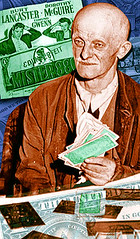
PREV ARTICLE
NEXT ARTICLE
FULL ISSUE
PREV FULL ISSUE
FINDING 'MR. 880': THE CASE OF THE ONE-DOLLAR COUNTERFEITER
Here's an interesting article from the New York Daily News about the hunt for a Depression-era counterfeiter.
-Editor
But in November 1938, the owner of a Broadway cigar store accepted it without a second glance. After all, even in the depths of the Depression, what shopkeeper could take the time to scrutinize a one-dollar bill? The storekeeper didn't realize he'd been had until he went to the bank and the teller pointed out the obvious irregularities on this particular slip of paper. Crude it may have been, but the bogus buck was soon getting sniffed over by the watchdogs of America's money supply, the Secret Service. But whoever slapped this new bill together was not in their league. In fact, no self-respecting counterfeiter would even bother with so small a sum. It was not worth the effort. Nevertheless, a fake is a fake, so the Secret Service dutifully opened a file, No. 880, put a New York City map on the office wall and, with a red thumbtack, marked the spot where the bill was passed. Year after year, hundreds of red tacks went up on the map. Merchants continued to take the bill, even though the already shoddy work deteriorated over the years. In addition to the fanciful artwork, one batch of bills featured an unbelievable typo - "Wahsington." Still, the dollars kept coming; nearly $5,000 worth would eventually pile up. They were all single dollars, and had been passed at local businesses - groceries, newspaper stands and bars. The Secret Service threw everything they had at finding the culprit, with no luck. America emerged from the Depression, then fought and won the second World War, but still there was no break in the case of "Old Mr. 880."
When they finally caught up with the perpetrator, they found a
toothless 72-year-old widower named Edward Mueller. An immigrant from Austria, his real name was Emerich Juettner.
-Editor
The tale caught the eye of St. Clair McKelway, a staff writer for the "New Yorker." McKelway's articles piqued the interest of Hollywood, and in 1950, Juettner's story came to the big screen. "Mr. 880" starred Burt Lancaster, playing the Secret Service agent. The role of the quirky counterfeiter went to none other than the actor beloved for his portrayal of Kris Kringle in "Miracle on 34th Street," Edmund Gwenn. After his brush with the law, Juettner went clean. When asked to explain why he was giving up counterfeiting, he said simply, "There isn't enough money in it."
So why did they call him "Mr. 880?"
Has anyone seen the film? I've always thought it would be a fun coin convention activity to have an evening screening of a good old film related to numismatics.
-Editor
To read the complete article, see:
Finding 'Mr. 880': The case of the $1 counterfeit
(www.nydailynews.com/news/ny_crime/2011/04/03/2011-04-03_ The Numismatic Bibliomania Society is a non-profit organization promoting numismatic literature. See our web site at coinbooks.org. To submit items for publication in The E-Sylum, write to the Editor at this address: whomren@gmail.com To subscribe go to: https://my.binhost.com/lists/listinfo/esylum All Rights Reserved. NBS Home Page Contact the NBS webmaster 
|
